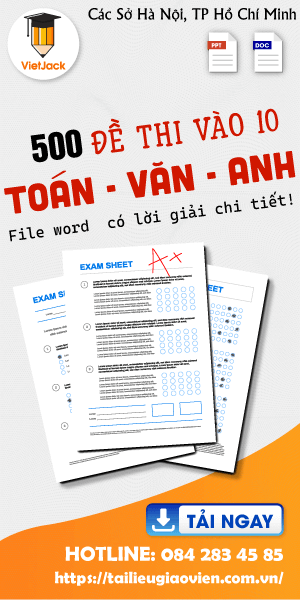Giáo án Tiếng Anh 9 (mới, chuẩn nhất) | Giáo án điện tử, bài giảng powerpoint (PPT) Tiếng Anh 9
Trọn bộ Kế hoạch bài dạy (KHBD) hay Giáo án Tiếng Anh 9 sách mới Global success, Friends Plus, Explore English mới, chuẩn nhất theo mẫu Kế hoạch bài dạy (KHBD) Tiếng Anh 9 của Bộ GD&ĐT đầy đủ giáo án word, giáo án điện tử, bài giảng PowerPoint (PPT) Tiếng Anh 9.
Giáo án Tiếng Anh 9 (mới, chuẩn nhất)
Xem thử Giáo án Anh 9 Global Xem thử Giáo án điện tử Anh 9 Global
Chỉ từ 250k mua trọn bộ Kế hoạch bài dạy (KHBD) hay Giáo án Tiếng Anh 9 Global Success bản word phong cách hiện đại, trình bày đẹp mắt, dễ dàng chỉnh sửa:
- B1: gửi phí vào tk:
1133836868- CT TNHH DAU TU VA DV GD VIETJACK - Ngân hàng MB (QR) - B2: Nhắn tin tới Zalo VietJack Official - nhấn vào đây để thông báo và nhận đề thi
Giáo án Tiếng Anh 9 Global Success
Unit 1: Local community
Unit 2: City life
Unit 3: Healthy living for teens
Review 1
Unit 4: Remembering the past
Unit 5: Our experiences
Unit 6: Vietnamses lifestyle: then and now
Review 2
Unit 7: Natural wonders of the world
Unit 8: Tourism
Unit 9: World Englishes
Review 3
Unit 10: Planet Earth
Unit 11: Electronic devices
Unit 12: Career choices
Review 4
Giáo án điện tử Tiếng Anh 9 Global Success
Giáo án điện tử Unit 1: Local community
Giáo án điện tử Unit 2: City life
Giáo án điện tử Unit 3: Healthy living for teens
Giáo án điện tử Review 1
Giáo án điện tử Unit 4: Remembering the past
Giáo án điện tử Unit 5: Our experiences
Giáo án điện tử Unit 6: Vietnamses lifestyle: then and now
Giáo án điện tử Review 2
Giáo án điện tử Unit 7: Natural wonders of the world
Giáo án điện tử Unit 8: Tourism
Giáo án điện tử Unit 9: World Englishes
Giáo án điện tử Review 3
Giáo án điện tử Unit 10: Planet Earth
Giáo án điện tử Unit 11: Electronic devices
Giáo án điện tử Unit 12: Career choices
Giáo án điện tử Review 4
Giáo án Tiếng Anh 9 Friends Plus
Nội dung đang được cập nhật ...
Giáo án điện tử Tiếng Anh 9 Friends Plus
Nội dung đang được cập nhật ...
Giáo án Tiếng Anh 9 Explore English
Nội dung đang được cập nhật ...
Giáo án điện tử Tiếng Anh 9 Explore English
Nội dung đang được cập nhật ...
Xem thử Giáo án Anh 9 Global Xem thử Giáo án điện tử Anh 9 Global
Lưu trữ: Giáo án Tiếng Anh 9 (sách thí điểm)
Tài liệu giáo án lớp 9 các môn học chuẩn khác:
Xem thêm đề thi lớp 9 các môn học có đáp án hay khác:
Tủ sách VIETJACK luyện thi vào 10 cho 2k11 (2026):
Đã có app VietJack trên điện thoại, giải bài tập SGK, SBT Soạn văn, Văn mẫu, Thi online, Bài giảng....miễn phí. Tải ngay ứng dụng trên Android và iOS.
Loạt bài Giáo án Sinh học lớp 9 mới, chuẩn nhất của chúng tôi được biên soạn bám sát nội dung sgk Sinh học 9 theo chuẩn Giáo án của Bộ GD & ĐT.
Nếu thấy hay, hãy động viên và chia sẻ nhé! Các bình luận không phù hợp với nội quy bình luận trang web sẽ bị cấm bình luận vĩnh viễn.
- Giáo án lớp 9 (các môn học)
- Giáo án điện tử lớp 9 (các môn học)
- Giáo án Toán 9
- Giáo án Ngữ văn 9
- Giáo án Tiếng Anh 9
- Giáo án Khoa học tự nhiên 9
- Giáo án Vật Lí 9
- Giáo án Hóa học 9
- Giáo án Sinh học 9
- Giáo án Địa Lí 9
- Giáo án Lịch Sử 9
- Giáo án GDCD 9
- Giáo án Tin học 9
- Giáo án Công nghệ 9
- Đề thi lớp 9 (các môn học)
- Đề thi Ngữ Văn 9 (có đáp án)
- Đề thi Toán 9 (có đáp án)
- Đề thi Tiếng Anh 9 mới (có đáp án)
- Đề thi Tiếng Anh 9 (có đáp án)
- Đề thi Khoa học tự nhiên 9 (có đáp án)
- Đề thi Lịch Sử và Địa Lí 9 (có đáp án)
- Đề thi GDCD 9 (có đáp án)
- Đề thi Tin học 9 (có đáp án)
- Đề thi Công nghệ 9 (có đáp án)




 Giải bài tập SGK & SBT
Giải bài tập SGK & SBT
 Tài liệu giáo viên
Tài liệu giáo viên
 Sách
Sách
 Khóa học
Khóa học
 Thi online
Thi online
 Hỏi đáp
Hỏi đáp

